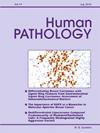INSM1: A highly sensitive marker for primary and metastatic Merkel cell carcinoma, superior to SOX11, pancytokeratin, and CK20
IF 2.6
2区 医学
Q2 PATHOLOGY
引用次数: 0
Abstract
Detection of Merkel cell carcinoma (MCC) micrometastases in sentinel lymph nodes (SLNs) often necessitates immunohistochemical studies like pancytokeratin (panCK) or CK20. However, panCK can label non-epithelial cells, particularly dendritic reticulum cells, complicating interpretation, while CK20 is absent in up to 24 % of MCCs, leading to potential false negatives. Recent evidence suggests SOX11 and INSM1 as sensitive nuclear neuroendocrine markers, though their comparative performance in this setting remains unclear. We assessed the expression of panCK (AE1/AE3, CK8/18, Cam5.2, and MNF116), CK20, SOX11, and INSM1 in 25 primary MCCs and 8 nodal metastases. SOX11 and INSM1 demonstrated the highest median H-scores (both 297), significantly outperforming panCK and CK20 (both 255) (p < 0.001). Although median H-scores for SOX11 and INSM1 were similar, 9 % (3/33) of cases lacked SOX11 expression. Direct comparison revealed significant differences in proportion and median H-score between SOX11 and INSM1 (p = 0.020 and p = 0.012, respectively), while intensity did not differ significantly (p = 0.317). When used alongside panCK, INSM1 yielded the highest combined sensitivity (100 %), surpassing panCK/CK20 and panCK/SOX11 combinations. These findings support the use of a panCK/INSM1 panel as a highly sensitive approach for detecting MCC micrometastases in SLNs. While INSM1 demonstrates robust performance, interpretation must account for background immunoreactivity in hematolymphoid elements, a possible and important diagnostic pitfall when using this marker in clinical practice. Further prospective studies with larger and more diverse cohorts may be needed to confirm these results and refine the optimal immunohistochemical strategy for MCC detection in SLNs.
INSM1:原发性和转移性默克尔细胞癌的高度敏感标志物,优于SOX11、全细胞角蛋白和CK20。
在前哨淋巴结(sln)中检测默克尔细胞癌(MCC)微转移通常需要进行泛细胞角蛋白(pancytokeratin, panCK)或CK20等免疫组化研究。然而,panCK可以标记非上皮细胞,特别是树突状网状细胞,使解释复杂化,而CK20在高达24%的mcc中缺失,导致潜在的假阴性。最近的证据表明SOX11和INSM1是敏感的核神经内分泌标志物,尽管它们在这种情况下的比较表现尚不清楚。我们评估了panCK (AE1/AE3、CK8/18、Cam5.2和MNF116)、CK20、SOX11和INSM1在25例原发性mcs和8例淋巴结转移中的表达。SOX11和INSM1表现出最高的中位h分数(均为297),显著优于panCK和CK20(均为255)
本文章由计算机程序翻译,如有差异,请以英文原文为准。
求助全文
约1分钟内获得全文
求助全文
来源期刊

Human pathology
医学-病理学
CiteScore
5.30
自引率
6.10%
发文量
206
审稿时长
21 days
期刊介绍:
Human Pathology is designed to bring information of clinicopathologic significance to human disease to the laboratory and clinical physician. It presents information drawn from morphologic and clinical laboratory studies with direct relevance to the understanding of human diseases. Papers published concern morphologic and clinicopathologic observations, reviews of diseases, analyses of problems in pathology, significant collections of case material and advances in concepts or techniques of value in the analysis and diagnosis of disease. Theoretical and experimental pathology and molecular biology pertinent to human disease are included. This critical journal is well illustrated with exceptional reproductions of photomicrographs and microscopic anatomy.
 求助内容:
求助内容: 应助结果提醒方式:
应助结果提醒方式:


